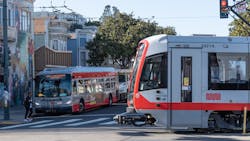Connect SF: A shared vision for transit in San Francisco
As the San Francisco Municipal Transportation Agency (SFMTA) recovers services, it will leverage ConnectSF, comprised of staff from the SFMTA, the San Francisco County Transportation Authority and the San Francisco Planning Department, to envision an effective, equitable and resilient transportation system.
After engaging with residents, community groups, businesses, youth organizations and other stakeholders to gather feedback, SFMTA has published the ConnectSF Transit Strategy. The strategy details how SFMTA can reinvest in the city’s transit system to achieve its shared vision of a growing, diverse and equitable city with transportation options that are accessible and affordable to all.
The vision
The ConnectSF Transit Strategy calls for four key investments to build the bold vision of San Francisco’s transportation system:
- SFMTA will make the current system work better with aggressive renewal and restoration of the current network.
- With targeted investments in street infrastructure, SFMTA will deliver a five-minute network that provides reliable service every five minutes on key bus and rail lines.
- By renewing and modernizing the rail system, SFMTA will build a Modern Muni Metro with increased speed, reliability and capacity for all riders.
- SFMTA will build more rail to San Francisco’s busiest places to get people quickly and reliably to their destinations. This includes a new subway along Geary and 19th Avenue, an extension of the Central Subway and a new Caltrain station in the Bayview.
To realize this vision, SFMTA says it will need to invest in creating a system that is better than before – faster, more reliable and more accessible. The ConnectSF Transit Strategy details the big changes the agency is calling for and where it will need funding to achieve them. Transit is essential to keeping the city moving, and a stable, ongoing funding source will be critical for helping San Francisco manage congestion and rebuild its economy.
Reshaping the transit network
Increasing service and making changes that enable new or better transit options are among ConnectSF’s top investment priorities. The Muni Forward toolkit already includes proven methods for accomplishing this. Bus lanes, transit signal priority, car-free zones and transit queue jumps are just some examples. The ConnectSF Transit Strategy goes beyond these methods and emphasizes the need to prioritize improvements for riders who depend on transit the most.
The ConnectSF Transit Strategy also calls for reshaping the way SFMTA operates transit in San Francisco. San Franciscans need access to a robust network of frequent buses and trains that take them all throughout the city-- rather than focusing primarily on trips downtown. This will require changes along streets and at intersections so that the only time a bus has to stop is for pick-ups and drop-offs, not to sit in traffic and wait at lights.
Delivering a modern Muni Metro that riders can rely on also requires catching up with the backlog of deferred maintenance and enhancing the light-rail system. For example, upgrading Muni Metro with a new train control system. In the future, in those areas of the city where no amount of bus improvements will be able to meet the demand, long-term planning will also include major new rail projects.
The ConnectSF Transit Strategy, along with the Streets and Freeways Study, identify projects and policies to be included in the San Francisco Transportation Plan and the updated Transportation Element of the San Francisco General Plan. Rebuilding and advancing the transportation system will take the continued commitment and involvement of city staff and community stakeholders.
